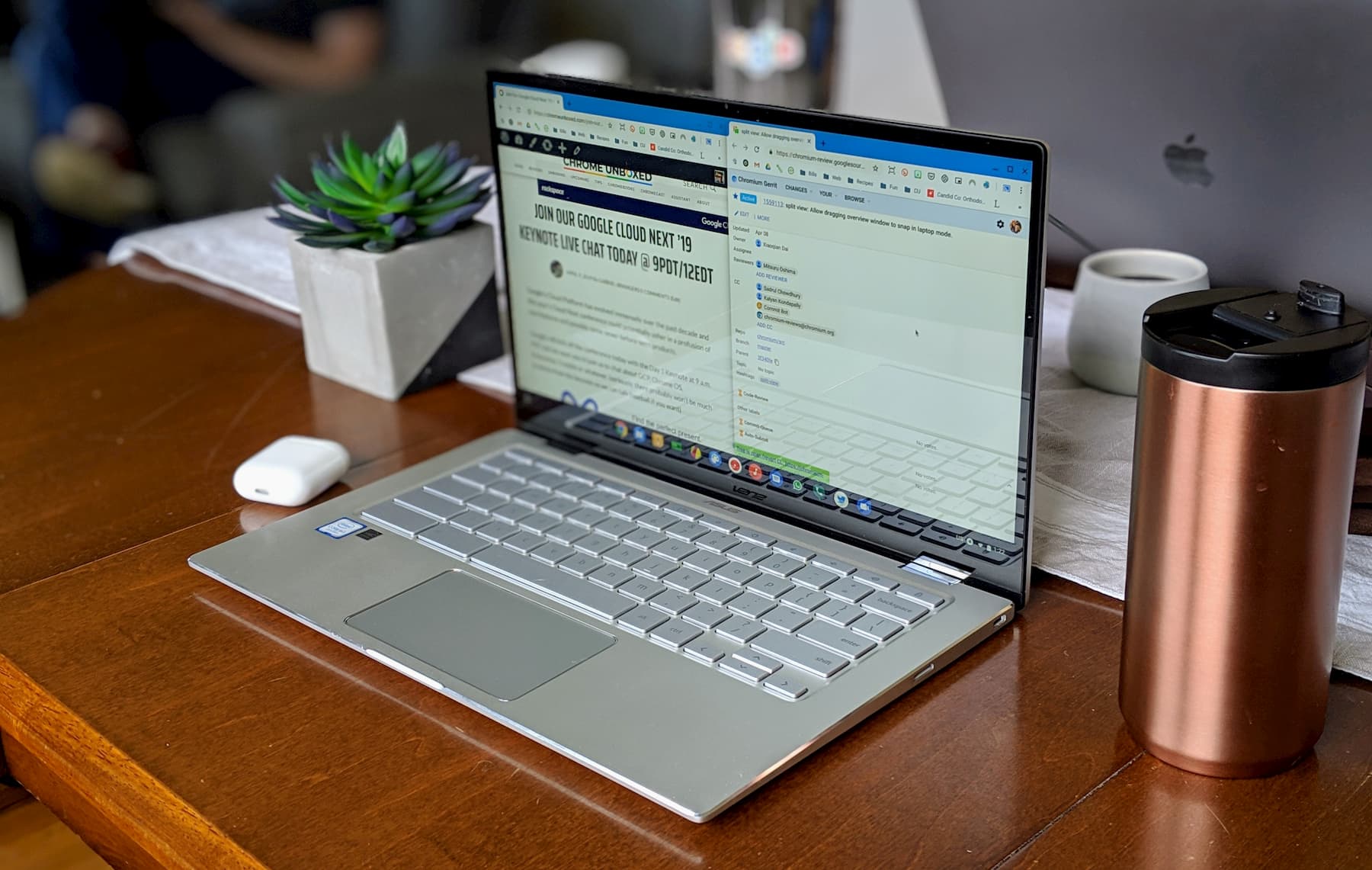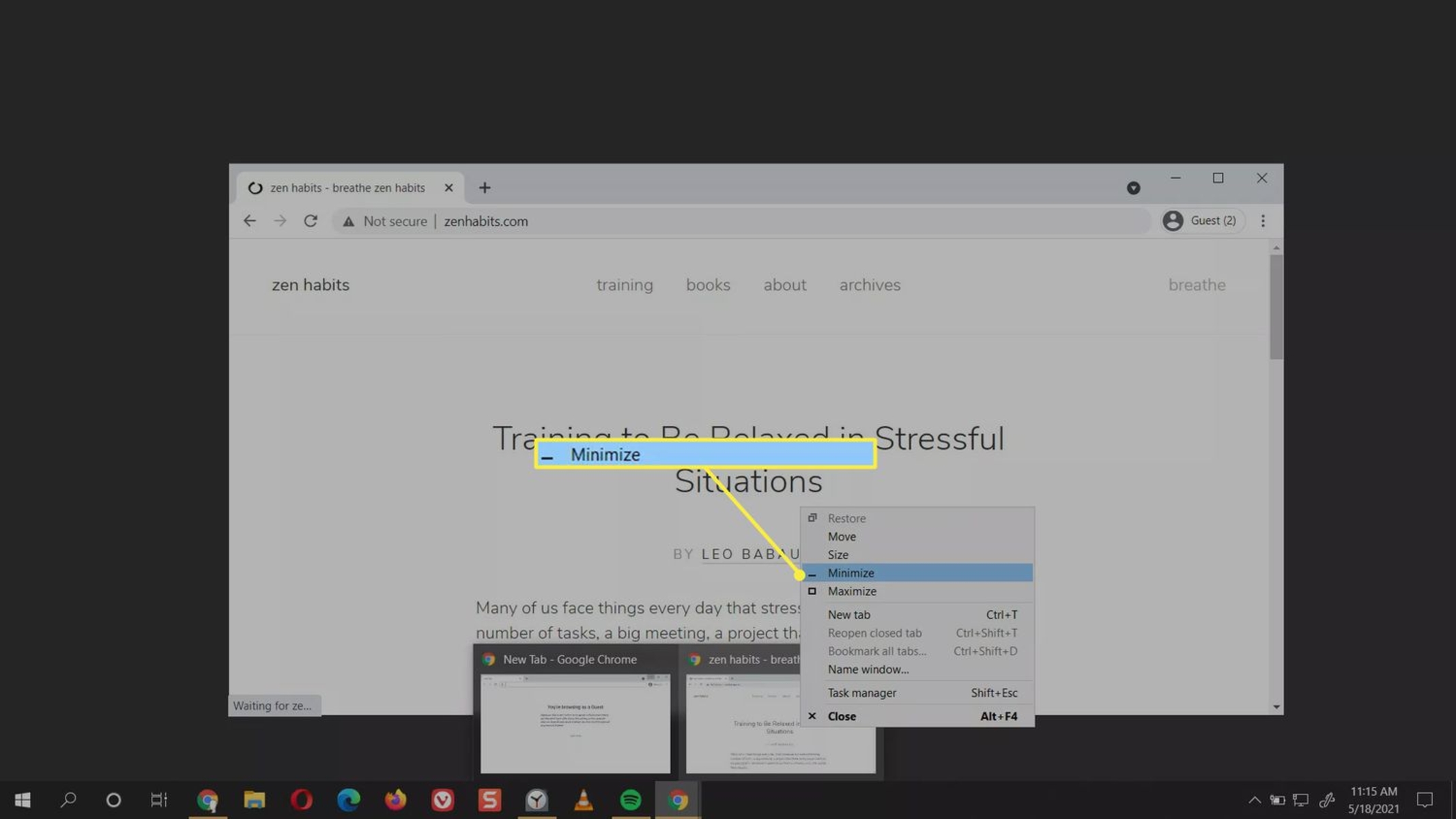Introduction
When working with multiple windows on your computer, it can get cluttered and overwhelming, making it difficult to focus on the task at hand. This is where the ability to minimize windows becomes incredibly useful. Minimizing windows allows you to temporarily hide them from view, providing a clean desktop and enabling you to easily switch between applications and documents.
In this article, we will explore various methods to minimize windows, ranging from using the minimize button to utilizing keyboard shortcuts, and leveraging the taskbar and system tray. Whether you are a casual computer user or a seasoned professional, mastering these techniques will help you enhance your productivity and streamline your workflow.
By minimizing windows, you can keep your desktop organized, reduce distractions, and quickly access the necessary applications or documents when needed. Whether you are juggling multiple work projects, conducting research, or just enjoying some leisure time on your computer, knowing how to efficiently minimize windows will make your life easier.
Throughout this article, we will provide step-by-step instructions and handy tips to help you navigate the various methods of minimizing windows. So, let’s dive in and discover the best ways to streamline your computer experience by minimizing windows.
Why Minimizing Windows is Useful
Minimizing windows serves several practical purposes, making it an essential skill for effective multitasking and maintaining a clutter-free workspace. Here are some key reasons why minimizing windows is useful:
- Improved Focus: By minimizing windows, you can remove visual distractions and concentrate on the task at hand. Having only the necessary windows displayed on your screen helps you stay focused and increases productivity.
- Organized Desktop: Minimizing windows allows you to create a clean and organized desktop. Instead of having numerous windows open and overlapping, you can minimize them to keep your desktop tidy and easily locate the applications or documents you need.
- Easier Task Switching: When you have multiple applications running simultaneously, minimizing windows provides a convenient way to switch between different tasks quickly. Instead of closing and reopening applications, you can easily navigate between them using minimized windows.
- Privacy and Security: Sometimes, you may need to keep certain windows out of sight to protect your privacy or sensitive data. By minimizing windows, you can ensure that confidential information is not visible to anyone who may have access to your computer.
- Reduced System Load: Minimizing windows can also help to optimize system performance and reduce resource consumption. When a window is minimized, it requires fewer system resources compared to when it is fully displayed, allowing your computer to run more efficiently.
Overall, mastering the skill of minimizing windows provides numerous benefits. It helps you stay focused, maintain an organized workflow, switch between tasks seamlessly, protect your privacy, and optimize your computer’s performance. Now, let’s explore the various methods you can use to minimize windows on your computer.
Methods to Minimize Windows
There are several methods you can utilize to minimize windows on your computer, offering flexibility and convenience based on your preferences and the applications you are using. Let’s explore some of the most common methods:
- Using the Minimize Button: The most straightforward method is to click on the minimize button located in the top-right corner of any window. This button is typically represented by a small horizontal line. Clicking it will minimize the window and remove it from your screen, but the application will continue to run in the background.
- Using Keyboard Shortcuts: Another quick way to minimize windows is by utilizing keyboard shortcuts. The specific shortcut may vary depending on your operating system, but common combinations include Windows key + M (for Windows) and Command key + M (for macOS). These shortcuts instantly minimize all open windows and display the desktop.
- Using the Taskbar: The taskbar, which is located at the bottom of your screen in Windows or the dock in macOS, provides another method to minimize windows. Simply locate the application’s icon on the taskbar or dock and right-click on it, then select “Minimize” from the context menu. The window will be minimized, and you can easily access it again by clicking on its icon.
- Using the System Tray: Some applications have a presence in the system tray, which is usually located in the bottom-right corner of the screen. Right-clicking on the application’s icon in the system tray will often provide an option to minimize the window associated with that specific application.
- Other Ways to Minimize Windows: Depending on the software you are using, there may be additional methods to minimize windows. Some applications have dedicated buttons or menu options for minimizing windows. Explore the application’s interface and documentation to find the most efficient way to minimize windows within that specific program.
These methods to minimize windows provide you with the flexibility to choose the one that suits your workflow and preferences. Whether you prefer mouse-clicks, keyboard shortcuts, or utilizing specific application features, mastering these methods will make your computer usage more efficient and organized.
Using the Minimize Button
One of the simplest and most common methods to minimize windows is by using the minimize button located in the top-right corner of any window. This button is typically represented by a small horizontal line. Here’s how you can use it:
- Locate the window you want to minimize.
- Look for the minimize button, usually in the top-right corner of the window.
- Click on the minimize button with your mouse pointer.
Once you click the minimize button, the window will shrink and disappear from your screen. However, the application will still be running in the background, and you can easily access the minimized window later.
To restore or bring back the minimized window, you have a few options:
- Click on the application’s icon in the taskbar (Windows) or the dock (macOS). This will restore the minimized window to its original size and position.
- Use the Alt + Tab keyboard shortcut (Windows) or Command + Tab (macOS) to cycle through open applications. When you reach the desired application, release the keys, and the minimized window will be restored.
- If you have multiple windows of the same application minimized, right-click on the application’s taskbar icon (Windows) or dock icon (macOS) and select the specific window you want to restore from the list.
The minimize button is a quick and convenient way to hide windows from your immediate view, keeping your desktop clutter-free and allowing you to focus on other tasks. It is especially useful when you temporarily want to set aside a window without closing the application altogether.
Keep in mind that the appearance and functionality of the minimize button may vary slightly depending on the operating system you are using and the specific application. However, the concept remains the same across different platforms and software.
Now that you know how to use the minimize button, let’s explore other methods to minimize windows and optimize your computer usage.
Using Keyboard Shortcuts
Keyboard shortcuts provide a fast and efficient way to minimize windows without the need to reach for your mouse. Different operating systems have their own keyboard shortcuts, but the general concept remains the same. Here’s how you can use keyboard shortcuts to minimize windows:
- Windows: Press the Windows key + M on your keyboard. This combination instantly minimizes all open windows and displays the desktop. To restore the minimized windows, press the Windows key + Shift + M.
- macOS: Press the Command key + M to minimize the active window. To restore the minimized window, click on the application’s icon in the dock.
Using keyboard shortcuts is particularly useful when you want to quickly minimize all open windows and focus on the desktop. These shortcuts save time and eliminate the need to manually click on each window’s minimize button.
In addition to these global shortcuts, some applications may also have their own specific keyboard shortcuts for minimizing and restoring windows. These shortcuts can vary depending on the application, so it’s worth checking the application’s documentation or preferences to see if any additional shortcuts are available.
Mastering keyboard shortcuts for minimizing windows can significantly enhance your productivity. By eliminating the need to use the mouse, you can navigate between tasks more efficiently and keep your workflow seamless.
Now that you know how to use keyboard shortcuts to minimize windows, let’s explore other methods that can help you optimize your computer usage.
Using the Taskbar
The taskbar, a prominent feature in Windows, provides a convenient way to minimize and manage windows. It is located at the bottom of the screen and displays icons representing open applications. Here’s how you can use the taskbar to minimize windows:
- Locate the window you want to minimize in the taskbar. Each open application will have its own icon.
- Right-click on the application’s icon.
- From the context menu that appears, select “Minimize”.
Once you select the “Minimize” option, the window associated with that application will be minimized, and you will have a clean desktop. To restore a minimized window, you can simply click on the application’s icon in the taskbar, and the window will be brought back to its original size and position.
In addition to minimizing windows, the taskbar also offers other helpful features:
- Task Switching: Apart from minimizing windows, you can also use the taskbar to switch between open applications. Simply click on an application’s icon in the taskbar to bring its window to the foreground.
- Pinning Applications: You can pin frequently used applications to the taskbar for easy access. Right-click on the application’s icon and select “Pin to taskbar”. The pinned applications will stay on the taskbar even when they are not running.
- Customization: Depending on your version of Windows, you can customize the taskbar by resizing it, rearranging icons, and adding or removing toolbars to suit your preference.
The taskbar is a powerful tool for managing windows and optimizing your workflow. Its convenience and ease of use make it a go-to method for minimizing and accessing windows quickly. Utilizing the taskbar effectively can significantly improve your multitasking abilities and productivity.
Now that you know how to use the taskbar to minimize windows, let’s explore other methods that can help you streamline your computer usage.
Using the System Tray
The system tray, also known as the notification area, is a section located in the bottom-right corner of the screen, typically adjacent to the taskbar. It provides a space where icons for various applications and system services are displayed. Some applications utilize the system tray to provide quick access to their functionalities, including the ability to minimize windows. Here’s how you can use the system tray to minimize windows:
- Locate the application’s icon in the system tray.
- Right-click on the application’s icon.
- From the context menu that appears, select the option to minimize the window associated with the application.
Once you select the option to minimize, the window will be hidden from view, providing a clutter-free desktop. To restore a minimized window from the system tray, simply right-click on the application’s icon and select the appropriate option to bring back the window.
Utilizing the system tray to minimize windows is particularly useful for applications that have constant presence or require background processes, such as messaging apps, antivirus software, or cloud storage services. It allows you to keep these applications running while minimizing their windows to reduce visual distractions.
It’s important to note that not all applications utilize the system tray for minimizing windows. The availability of this feature depends on the application’s design and functionality. Therefore, not every application’s icon in the system tray will offer a minimize option.
The system tray provides a convenient way to manage windows without cluttering the taskbar or desktop. By leveraging the capabilities of the system tray, you can easily minimize and restore windows for applications that support this functionality, keeping your desktop organized and optimizing your workflow.
Now that you know how to use the system tray to minimize windows, let’s explore other methods that can assist you in maximizing your computer usage.
Other Ways to Minimize Windows
In addition to the common methods mentioned earlier, there are other ways you can minimize windows depending on the software you are using. These methods may vary based on the application’s design and features. Here are a few examples of other ways to minimize windows:
- Dedicated Buttons: Some applications have dedicated buttons within their interface for minimizing windows. These buttons are usually represented by an icon or a label indicating their purpose. Look for these buttons in the application’s toolbar or menu and click on them to minimize windows.
- Menu Options: Certain applications provide specific menu options to minimize windows. These options can typically be found within the “Window” or “View” menu of the application. Explore the menus and look for options like “Minimize Window” or similar names to utilize this method.
- Customizable Shortcuts: Advanced applications often allow users to customize their own keyboard shortcuts. Check the preferences or settings of the particular software to see if you can assign a shortcut for minimizing windows. This way, you can create a personal shortcut that suits your needs and usage patterns.
It’s important to familiarize yourself with the interface and functions of each application you use. Take some time to explore the menus, buttons, and options available to discover if there are any specialized methods provided for minimizing windows.
Remember that these additional methods may only be applicable to specific applications or software. It’s always a good idea to consult the application’s documentation or support resources to learn more about the available features and functionalities.
By utilizing the various methods mentioned in this article and exploring any additional options provided by specific applications, you can personalize your approach to minimizing windows and optimize your computer usage experience.
Now that you’re familiar with different ways to minimize windows, let’s summarize the methods discussed in this article and wrap up our exploration of this essential skill.
Conclusion
Minimizing windows is a valuable skill that can greatly enhance your productivity and organization while using a computer. By knowing how to effectively minimize windows, you can reduce distractions, keep your desktop uncluttered, and seamlessly switch between tasks and applications.
In this article, we explored various methods of minimizing windows, including using the minimize button, keyboard shortcuts, the taskbar, and the system tray. Each method offers its own advantages and can be tailored to suit your preferences and workflow.
Remember, the minimize button located in the top-right corner of windows provides a simple and quick way to hide a window from view. Keyboard shortcuts, such as Windows key + M or Command key + M, allow you to instantly minimize all open windows for a clean desktop. The taskbar serves as a central hub for managing minimized windows and provides easy access to restore them. The system tray can be utilized by certain applications to minimize windows and keep them running in the background.
In addition to these common methods, some applications may offer dedicated buttons, menu options, or customizable shortcuts for minimizing windows. It is worth exploring each application’s interface and documentation to discover any specialized methods they provide.
By mastering the art of minimizing windows, you can improve your focus, create an organized workspace, and efficiently manage your tasks. Whether you are a student, professional, or casual computer user, applying these methods will help you navigate through various applications and documents with ease.
So, take the time to familiarize yourself with these techniques and incorporate them into your daily computer usage. The ability to minimize windows effectively will undoubtedly lead to a more streamlined and productive digital experience.

























